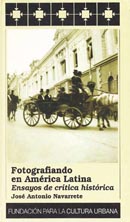Since the year 2001, the Urban Culture Foundation (FCU) in Venezuela has been implementing an inter-generic multiple editorial program that includes the FCU’s main collection, the Cuadernos series special editions. Its endeavor counts on the auspices of profound reality-prying studies that allow for sharing a coherent conception about the cultural scope of social processes. This painstaking and specialized work has given the FCU solid grounds to build on as a space open to knowledge and the spread of that knowledge.
Before the Photographing in Latin America. Historic Critical Essays, put out under the FCU seal, lies a chance to bear out the significance of the abovementioned publishing program. Photographing… is a compilation of texts penned by Cuban researcher Jose Antonio Navarrete and based on an array of systematic studies on Latin American photography. His conceptions on the twists and turns this specialty has taken in Latin America suggests a history of photography that tries to reason on an expression that “simultaneously acts against and for the arts, rather than being a contradictory movement of clashes versus capitulations from its own respect, in complicated and different forms of collisions, contacts and mutual exchanges.”
Navarrete contextualizes and makes the most of the different knowledge through plural theorization on the art of photography from a critical-historical standpoint. In a first group of essays, he delves into the construction of the historiographic field of photography as a discipline, thus projecting a more complex spectrum by considering the photographic registry from archival, class, genre and ethnic notions –a job commonly undertaken from a view of technical considerations and esthetic connotations.
In a second bloc, he clusters those topics whereby photography addresses the layout of Latin America’s national imageries between the 19th and the early 20th centuries with respect to good manners, national portraits, the emergence of identity models in the course of ethnographic, archeological and gospel-pushing campaigns. He wraps things up with his initial hypothesis, one he diversifies in different texts anointed to such boldface names as Eugenio Courret, Charles D. Fredicks and Muybridge, whose presence in parts of the continent helped whip these locations’ iconographic and cultural configuration into shape.
In the appendix, he goes back over the forewords’ headings as far as the historic studies on photography are concerned, a phenomenon that saw the light of day back in the 1920s and 30s. By doing so, he broached different efforts in the international and Latin American scene from both an academic viewpoint and in association with certain exhibiting projects.
The compilation proposes –on the basis of strict methodology- the provision of a useful cultural tool for society. Following a serious reflection, Navarrete goes into the imagery of Latin American creators who sway between the recovery of their origins, the undertaking of European experimentalisms and the concretion of a particular universe time and again. Convinced of the art’s social value, he tours different artistic discourses in which light, color, feelings and ideas make up the context’s photographic art.
The FCU’s effort with this publishing project has really paid off. It’s marked with issue 76 under the collection design of ProduGrafica and the contribution chipped in by a team of experts. Photographing… was printed by Graficas Lauky with the cover designed by John Lange in which he used a picture of Federico Carlos Lessmann, whose ties are indeed very suggestive. In as many as 222 pages, featuring B&W sheets, the collection underlies a number of criteria that pivot on the organic unit among the scientific method, the theory and the praxis. In a bid to nudge the public, the author sticks to the didactic pathway leading to a kind of knowledge buildup that hinges on the problematic analysis of reality and takes us to the understanding of it and its subsequent transformation through accurate and unbiased vision. This vision, in turn, allows for the enjoyment of the many sides the topic has to offer. Holding on to a straightforward discourse that relies on his liking for bold conceptualism, this grand tour embraces the concepts of a very particular dynamics that eventually names the different sections and defines the inner layout of the whole. In the launch of this masterpiece, Cuban critic Felix Suazo said:
Recognized as one of the most consistent researchers of photography in the continent, this author culls a body of ideas in this volume, ideas he previously thought up for papers and specialized publications. However, in this compilation they actually acquire discursive and conceptual coherence of their own as heirs of a developing way of thinking. This is an erudite book, written with soberness and documental accuracy, whose arguments stand tall over rigorous methodology.
And it all comes alive from a semiotic universe that grows deep theoretical roots, like the existence of different ways of reflecting the basics of the kind of art that defines the course of the artistic memory. This is a publication that questions a set of hackneyed, groundless topics and puts photographic art right under the limelight this expression deserves for its originality and advance.
Following up on the Aristotelian thinking: “There’s no such thing as current memory in the current times. There’s only a hunch of the present; there’s hope in the future, and there’s memory of the past.* Memory has the ability to overcome time and organize in it the sequence and harmony of the developments. And it’s just because memory –especially the written memory– exerts its tremendous influence on fleeting testimony in an effort to save thinking, to toss it into a paradoxical and prodigious flight. This book is one of those signs of that survival.

Previous publication NadalitoThe photography of mental processes
Next publication The Eyes of Alfonso Reyes
Related Publications

How Harumi Yamaguchi invented the modern woman in Japan
March 16, 2022
Giovanni Duarte and an orchestra capable of everything
August 26, 2020











